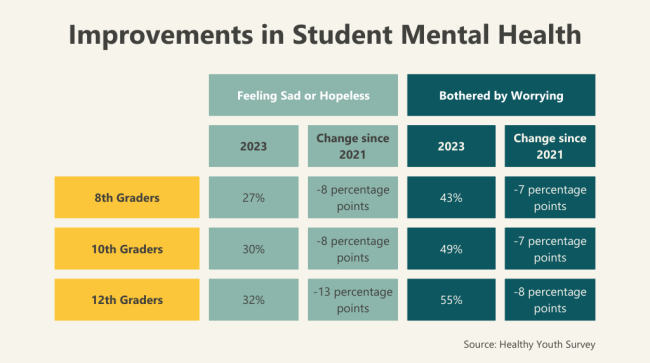Media Contact
Katy Payne she/her
360-764-0201
In recent years, Washington state has intentionally invested in supports for student well-being and academic success. Those efforts are paying off, as students report improvements in their mental health and academic outcomes in the 2023 Healthy Youth Survey (HYS).

First introduced in 2002, Washington’s Healthy Youth Survey provides education leaders and policymakers with a unique opportunity to respond to the needs and interests of students at both the state and local levels. The survey is administered every other year to students in grades 6, 8, 10, and 12, and is always voluntary and anonymous. More than 217,000 students participated in the HYS in the fall of 2023.
“Like their peers across the nation, the pandemic impacted our students’ mental health, well-being, and engagement in school,” said State Superintendent Chris Reykdal. “Over the past few years, our state has invested millions of dollars in evidence-informed programs, support staff, and professional development to address those impacts. The new HYS results are a breath of fresh air because it means our efforts are working.”
“I’m proud of the tireless efforts of our students, families, educators, and community partners to support each and every Washington student,” Reykdal continued. “In my upcoming biennial budget request to the Governor and Legislature, I will be putting forward proposals to sustain and grow the progress we have made through programs that work.”
Student Mental Health
Supporting student mental health has long been a priority for the Office of Superintendent of Public Instruction (OSPI). With recent investments of federal and state funding, more students are receiving mental and behavioral health services, and more educators are prepared to respond to student emotional distress.
Recognizing the pandemic’s impact on student mental health, OSPI invested a portion of its federal emergency relief funds in a statewide initiative, operated through the nine regional educational service districts (ESDs), that provides direct supports to students in prevention education and coordinated intervention. With emergency relief funds expiring in September 2024, Superintendent Reykdal and the ESDs asked the 2024 Legislature to invest in sustaining the program, which data show has been making a difference. The Legislature made progress on that request, and OSPI will continue to advocate for student access to needed mental and behavioral health supports.
Washington’s focus on supporting student mental health is resulting in positive outcomes for students. In the 2023 HYS, students reported improvements across a range of mental health indicators, including thoughts of attempting suicide, persistent feelings of being sad or hopeless, and anxiety.
Across all students in grades 8, 10, and 12, approximately 15% reported they had seriously considered attempting suicide in the past year. This is the lowest rate amongst 10th graders since 2006, and the lowest rate amongst 8th and 12th graders since 2010.
As compared to 2021, there were also decreases in the percentages of students who reported feeling so sad or hopeless in the previous year that they stopped doing some usual activities, as well as in the percentages of students who reported that they were bothered by being unable to stop or control worrying in the previous two weeks.

Overall, Washington’s students saw improvements in mental health, though there are gaps for some student groups. Students with disabilities, students from migratory working families, and students who identify as LGBTQ+ reported higher levels of feeling sad or hopeless as compared to their peers. There is a continued need for emphasis on supports and resources for students who may be more at risk than their peers.
In an indication of the important roles that Washington’s schools and families play in student mental health, more students reported opportunities for support in 2023. The rate of students who reported they have an adult to turn to when they feel sad or hopeless reached 57% for 8th graders, 59% for 10th graders, and 62% for 12th graders. These rates mark increases of 5 percentage points, 9 percentage points, and 8 percentage points, respectively, as compared to 2021.
The importance of supporting student mental health is also reflected at the federal level. President Joe Biden’s budget for fiscal year 2025 includes $216 million for School Safety National Activities, including $40 million to increase the number of school counselors, school psychologists, social workers, and other health professionals who support the mental health needs of students.
Academic Success
Washington’s students reported impacts to their academic success during the pandemic, and the state has invested in evidence-based programs and projects to support student engagement with and success in school. Results from the 2023 HYS show that students are seeing improved grades and a higher commitment to school.
OSPI invested a portion of its federal emergency relief funding in projects and programs that support student engagement in school. These include:
- The Ninth Grade Success Initiative, a partnership between OSPI and Stand for Children’s Center for High School Success, which coaches school districts to create systems that support students in passing all their ninth grade classes – an indicator of on-time graduation.
- OSPI’s Building Bridges Program, which provides grants to community-based organizations that work to close opportunity gaps for students by offering mentoring or coaching, school credit retrieval, or alternative education programming.
- OSPI’s Open Doors Youth Reengagement Program, which provides education and support services to students ages 16–21 who are facing barriers to completing high school.
- Programming operated by College Success Foundation, which supports students identified as low-income in accessing postsecondary education.
The Legislature made investments in some of these initiatives during the recent legislative session, though additional state funding is needed as federal relief funds expire. Superintendent Reykdal will continue to advocate for these needed supports in his upcoming biennial budget.
In the 2023 HYS, fewer students across grades 8, 10, and 12 reported a low commitment to school. The HYS measures this by asking students whether they find their schoolwork meaningful, whether they believe their learning will be important in the future, and whether they have skipped classes in the previous month. Students in 12th grade reported low commitment to school at a rate of 50% while students in 10th grade reported low commitment to school at a rate of 52%, representing decreases of 5 percentage points for both groups compared to 2021. Students in 8th grade reported low commitment to school at a rate of 56%, a decrease of 3 percentage points since 2021.
“While we are seeing excellent gains, it remains true that too many students have lost course options in middle and high school,” Reykdal said. “Every year, more credit mandates are proposed or passed at the expense of student electives. Students live in a digital world of customization, and they want more choices returned to them in school. As they get more control over their learning, we will continue to see improvements in student commitment to school and to their futures.”
Students also reported improved grades in the 2023 HYS. The rate of students reporting lower grades (defined as mostly C’s, D’s, or F’s) decreased or held constant across all 8th graders, 10th graders, and 12th graders as compared to 2021. The greatest improvement was for students in 8th grade, who saw this rate decrease by 6 percentage points to 20%.
For More Information
- OSPI Explains: What Is the Healthy Youth Survey, and How Are the Results Used?
- OSPI video: Healthy Youth Survey
- Healthy Youth Survey website
- OSPI Fact Sheet: Youth Mental Health (English/Spanish)
- Washington State Department of Health
- Washington State Health Care Authority
- Washington State Liquor and Cannabis Board






